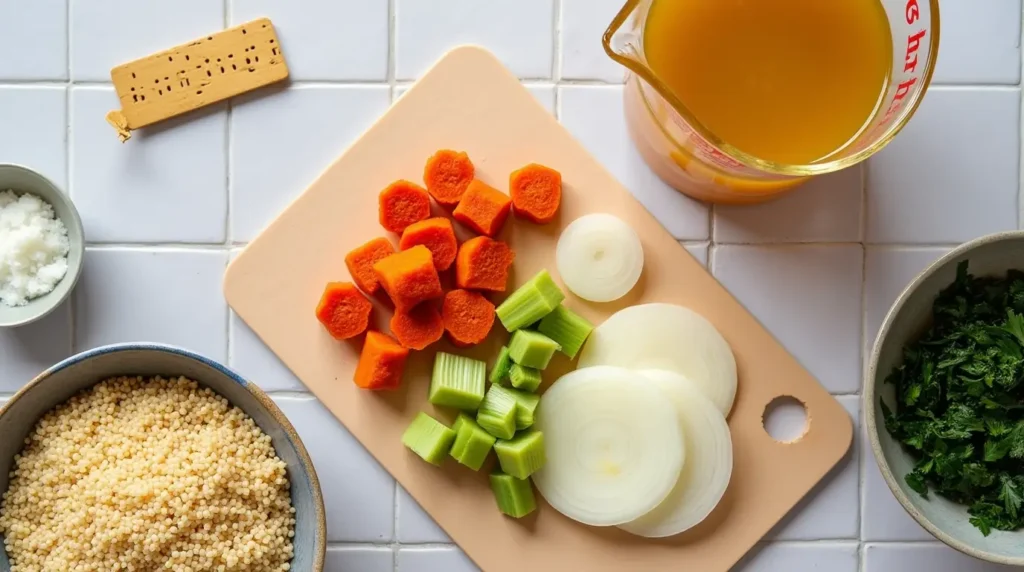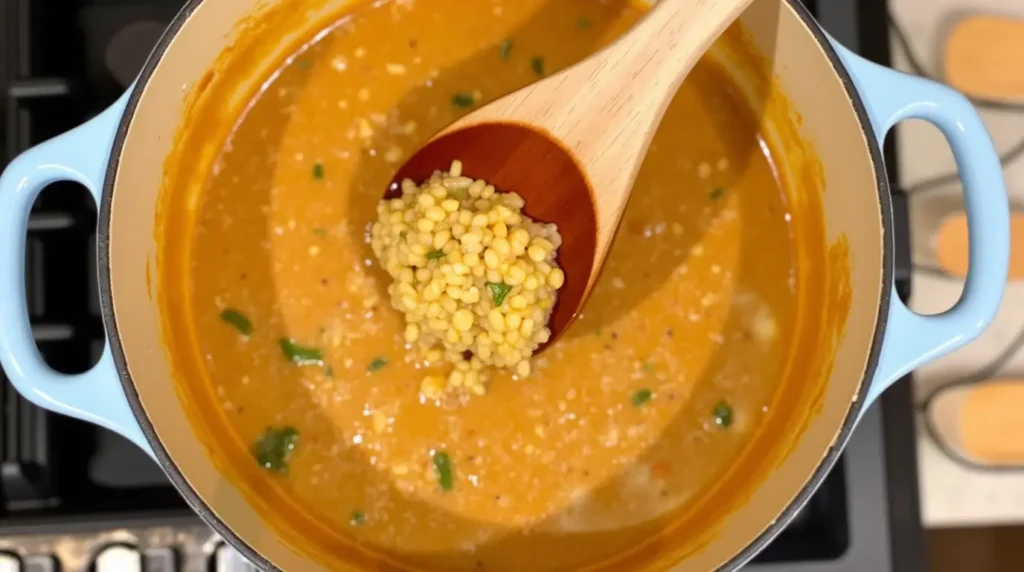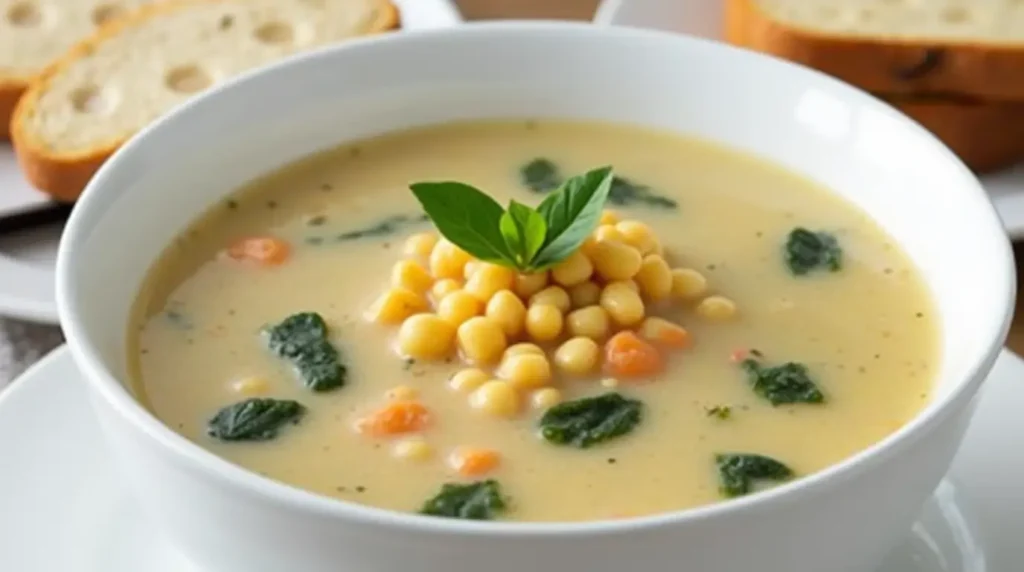“Italian penicillin soup” has been the affectionate name generations of Italian families gave to their pastina recipe – a reliable comfort food that warms bellies and fights off colds. This classic Italian soup brings incredible comfort and takes just 30 minutes to prepare, making it an easy weeknight recipe. Tiny pastina pasta, fresh vegetables, and your choice of chicken or vegetable broth are the simple ingredients that make this easy pastina soup adaptable to any dietary preference.
A bowl of this traditional Italian penicillin recipe offers comfort and nourishment when you’re feeling under the weather or just need something soothing. The sprinkle of Parmesan cheese on top creates a wholesome, one-pot meal that heals and delights your taste buds.
Let’s tuck into my family’s treasured pastina recipe that has spread warmth and comfort through generations.

Table of Contents
What is Traditional Pastina Soup
Pastina translates to “little pasta” in Italian and consists of tiny pasta pieces approximately two millimeters in diameter. This humble peasant dish evolved into a cherished recipe that Italian families have passed down through generations, becoming a staple in Italian soups.
Origin of Italian Penicillin Soup
Pastina soup, also known as pastina in brodo or minestrina, served as cucina povera (poor food) in the harsh Italian mountain regions during the 19th and 20th centuries. The soup earned its nickname “Italian penicillin” because of its healing properties over time. This Italian pasta soup became a staple in Italian-American culture, especially in areas with large Italian communities. The warm broth soothes and comforts, while the easily digestible pasta works well for people who feel sick.
Key Ingredients and Their Benefits
These ingredients are the foundations of authentic Italian penicillin soup:
- Base Broth: Rich chicken or vegetable stock provides hydration and warmth
- Aromatic Foundation: Onions, carrots, and celery create a flavorful base
- Pastina: The smallest pasta type made, accessible to more people in various shapes like stars, alphabet, or tiny rounds
- Parmesan Rind: Adds depth and umami flavor to the broth
- Fresh Herbs: Parsley or basil boost the soup’s aromatic profile
The ingredients blend into a gentle, nourishing meal that keeps people fed and takes less than 15 minutes to prepare. Children love the tiny pasta shapes, while the blended vegetables sneak in extra nutrition as hidden veggies. On top of that, it adapts to different dietary priorities, which makes it perfect for various nutritional needs.
Essential Tools and Ingredients

A perfect pastina recipe begins with quality ingredients that play specific roles in this healing soup.
Choosing the Right Pastina
Tiny pasta shapes make up the star ingredient of this Italian soup recipe. Each piece measures about 2 millimeters in size. You’ll find popular varieties like stelline pasta (little stars), acini di pepe (peppercorn-shaped), and orzo. High-quality pastina made from semolina flour delivers authentic results. Stelline might not always be available, but fregola or Israeli couscous serve as great substitutes.
Broth Options
A good broth forms the foundation of pastina soup. Homemade chicken broth gives you the most authentic flavor and healing benefits. Store-bought options also work well when you’re short on time. The broth’s flavor gets a boost when you add a Parmesan rind during simmering. Vegetarians can use organic vegetable broth with minimal ingredients and low salt.
Optional Add-ins for Extra Healing
These powerful add-ins boost your pastina soup’s therapeutic properties:
- Fresh ginger and garlic: Support immune function and reduce inflammation
- Lemon juice: Rich in vitamin C and helps reduce phlegm
- Fresh herbs: Parsley or oregano for added nutrients
- Reishi mushroom powder: Acts as an adaptogen to help body recover
Leafy greens like spinach or kale add extra nutrition to your customized soup. You can keep the broth in the refrigerator for 3-4 days. The pastina tastes best when cooked fresh at serving time to maintain its texture.
Step-by-Step Cooking Instructions: How to Make Pastina Soup
Start your easy Italian soup by making a flavorful base broth that is the foundation of this healing recipe.
Preparing the Base Broth
Add chicken or vegetable broth to a large pot with a lid. Mix in chopped onions, carrots, celery, and a Parmesan rind to boost the flavor. The mixture should come to a boil over medium-high heat, then reduce to medium-low. Let the vegetables simmer until they become tender, about 15-20 minutes.

Adding and Cooking Pastina
The broth should reach a rolling boil before you add your chosen pastina. Keep stirring to prevent the tiny pasta for soup from sticking to the bottom. Your pasta will need 3-4 minutes to cook until it reaches al dente consistency. Note that pastina will keep absorbing liquid after cooking, so timing is vital.
Tempering the Egg
You can make a protein-rich version by adding a tempered egg to improve both nutrition and texture. Start by whisking one egg in a small bowl until well combined. Then add two spoonfuls of hot broth to the beaten egg while stirring quickly. This vital step keeps the egg from scrambling when you add it to the soup. Add the tempered mixture to the pot and stir continuously until it blends completely.
Final Seasoning Tips
Check the soup’s taste and adjust seasonings as needed. Take out the Parmesan rind before you serve. The hot soup looks best in bowls garnished with:
- Fresh parsley garnish
- Grated Parmesan cheese
- A light drizzle of olive oil
To prep meals ahead, keep the broth and pastina in separate containers. This method stops the pasta from getting too soft and helps you maintain the perfect texture when you reheat it.
Common Mistakes to Avoid
The texture and taste of your pastina soup depends on avoiding common mistakes during preparation.
Pasta Cooking Issues
Pastina’s small size creates several cooking challenges. We noticed these tiny pasta shapes stick together and to the pot bottom. You need to stir every minute to prevent clumping and cook evenly. The cooking time stands out as the most important element – pastina needs just 5-7 minutes to reach perfect tenderness.
You should store cooked pastina separately from the broth to keep it from turning mushy. Another option is to cook only what you’ll eat right away. Before refrigerating leftovers, pat the cooked pastina dry with paper towels to remove extra moisture.

Broth Temperature Problems
The right temperature will give your pastina soup its ideal consistency. Let the broth simmer steadily instead of bringing it to a rolling boil – this stops the pastina from breaking apart. Adding cold pastina to hot broth can throw off temperatures and affect how it cooks.
Tips that will give you perfect pastina soup:
- Keep your broth temperature steady while cooking
- Put pastina in individual serving bowls to control portions better
- Store your broth and pasta in separate containers for 3-4 days
- Freeze only the broth since frozen pastina gets mushy
- Add a protective coating of butter to cooked pastina before mixing it with broth
The quickest way to great results is treating pastina like fine pasta. Cook it al dente in salted water and mix it with hot broth right before serving. This technique gives you perfect texture and keeps all the soup’s therapeutic benefits.
Conclusion
Traditional pastina soup shows evidence of Italian wisdom passed down through generations. This comforting and healing dish uses simple ingredients and preparation methods. You can make this beloved “Italian penicillin” by following our step-by-step instructions on how to make pastina soup.

The perfect pastina soup needs proper temperature control and consistent stirring. You should store the broth and pasta separately. These techniques will give your soup its therapeutic qualities and authentic taste that Italian families have cherished for generations.
The soup becomes even more healing when you add immune-boosting ingredients like fresh ginger, garlic, or leafy greens. This versatile recipe works with dietary needs of all types while keeping its comforting essence. As a kid-friendly, one-pot meal, it’s perfect for busy weeknights when you need a quick and nourishing dinner option.
We hope this family pastina recipe adds warmth and wellness to your kitchen. You can find more recipes and meal ideas that blend Italian tradition with nutrition at recipesnutritious.com. Good cooking comes from understanding the ingredients and the love behind time-tested recipes.
FAQs
Q1. How do you properly cook pastina for soup? To cook pastina for soup, add it directly to simmering broth and stir frequently to prevent clumping. Cook for about 3-4 minutes until al dente. There’s no need to drain the pastina as it cooks in and absorbs the flavorful broth.
Q2. What makes pastina soup so comforting? Pastina soup is often called “Italian penicillin” due to its comforting properties. The tiny pasta is easy to digest, while the warm broth soothes the throat and provides hydration. Its association with childhood and being served when sick adds to its reputation as a classic Italian comfort food.
Q3. Can I customize pastina soup for added health benefits? Yes, you can enhance the healing properties of pastina soup by adding ingredients like fresh ginger, garlic, lemon juice, or leafy greens. These add-ins can boost immune function, reduce inflammation, and increase the soup’s nutritional value.
Q4. How long can I store pastina soup? For best results, store the broth and cooked pastina separately in the refrigerator for up to 3-4 days. When ready to serve, reheat the broth and add the pastina just before eating to maintain the perfect texture.
Q5. What’s the secret to making flavorful pastina soup? The key to a flavorful pastina soup lies in its broth. Use a rich homemade chicken or vegetable stock as the base. Adding a Parmesan rind during simmering can significantly enhance the flavor. Don’t forget to season with fresh herbs like parsley or basil before serving, and consider customizable toppings to suit individual tastes.

